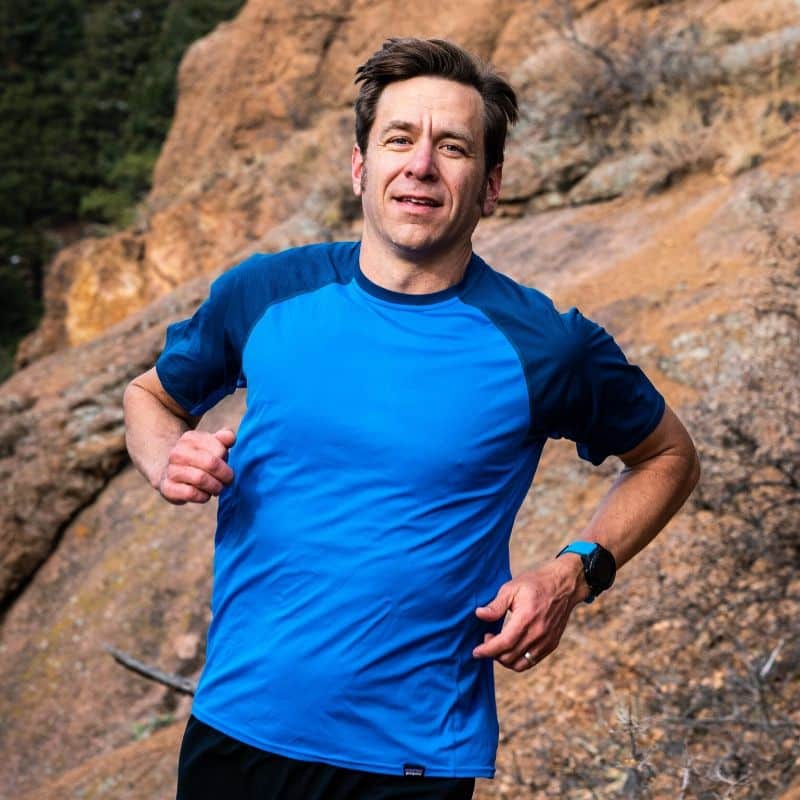
An Ultrarunning Coach’s Guide to Reindeer (Training) Games
By Jason Koop,
Head Coach of CTS Ultrarunning
It’s Christmas week and that means your inboxes are likely filled with newsletters and advertorials trying to cajole you into buying more of the ‘the best gifts for runners’ and ’must haves for the trail runner’. Fortunately for you, I have some better more whimsical content lined up in the blog this week. Feel free to read this in between your next cup of (leaded) egg nog (seriously, the bourbon helps) and 3rd helping of sugar cookies.
Living near the base of NORAD, my hometown trails are intertwined with the base’s super secretive entry points. Most of these points are fairly benign, consisting of your run of the mill razor wire, armed guards, biometric scanners, moats, drawbridges, sharks with laser beams attached to their foreheads, dragons and other such deterrents. When confronted with these inhospitable looking entrances, I usually just run away, happy not to not have my gels taken for state’s evidence. However, on a number of occasions I’ve ‘accidentally’ stumbled into the base’s command center for their world renown Santa Tracker (you can find the interview I conduced with Mr. Claus last year here). If you are ever in the area, the entry point is located in between the XXXXXXXXXX (redacted by state department) trail and intersection of XXXXXXXXXX (redacted by state department). The entrance kind of looks like this-
In any case, it turns out the Santa Tracker command post has had its security downgraded as part of an overall military reorganization, inclusive of the incoming Space Command and yet-to-be-announced Tooth Fairy Platoon. And so, the socially distanced Santa Tracker staff were happy to have me in for a few Zoom calls with the Big Guy.
It should come as no surprise that reindeer are excellent ultra-endurance athletes. Being that Santa is a progressively thinking Claus, he enlisted my services to help Dasher, Dancer, Prancer, Vixen, Comet, Cupid, Donner, Blitzen and Rudolph in their training leading up to this year’s Big Event. It’s a task I didn’t take lightly, as all of the presents for the world’s good little girls and boys would be on the line. Nonetheless, I accepted, and we got to work with the reindeer team earlier this year. Here’s how I approached solving this unique ultra-endurance problem.
Reindeer (Training) Games
As with any new athlete, my first step in this endeavor was to better understand the demands placed on the reindeer during Christmas. Delivering presents around the world is no small feat (or hoof?). Santa’s team of reindeer have to travel to 800 million homes all while hauling a gigantic sled filled with presents. The team uses the different time zones to their advantage, so they have 34 hours to complete the activity. The 34-hour duration places the reindeer firmly in the ultra-endurance domain, and the timeframe is very similar to any Leadville Trail 100 runner wanting to make the cutoffs. They would need to be able to push hard enough to make the cutoffs (sunrise, in this case) but not so hard that they suffer horrendously after the equivalent of the Mayqueen Aid Station. Were the reindeers human, we could guess that they could sustain between 35-45% of their VO2max for the event. My guess, though, is that the reindeer would actually be utilizing anywhere between 50-60% of their VO2max as they are highly trained and less subject to the neuromuscular fatigue associated with ultramarathon humans.
To meet the demands of Christmas present delivery, the reindeer would have to have outstanding aerobic engines and very good locomotion economy. Fortunately, the reindeer are naturally excellent aerobic athletes. In fact, their cousins the pronghorn antelopes have estimated VO2max values in excess of 200 ml/kg/min. It’s not a far stretch to say that with the addition of some high quality interval work, a well-structured training program, and a sprinkle of Christmas spirit, that the collective team of 9 sleigh pullers could utilize over 500L of oxygen per minute at their collective VO2max intensity, nearly 100 times that of renown ultrarunner Matt Carpenter.
To further enhance their natural aerobic capabilities, I had the reindeer do block style RunningIntervals with very low volume in January, February and March. As the year progressed, they gradually built up their volume with a host of long trots and back-to-back gallops. Ultimately, the reindeer training capped off at a very reasonable 12 hours a week for their maximum amount of training time.
(Authors note- this is a really good case where tracking training volume by time, not miles is beneficial. Had I tracked their training by miles, it would number in the thousands per week and far surpass Strava’s ability to keep track)
The real magic in reindeer locomotion is not from their sheer aerobic potential. Santa’s reindeer possess a nearly nonexistent cost of transport, or trotting economy. They do this through the magic of Santa’s sleigh, which offers frictionless transfer of power from the reindeer hoofs to the air in order to provide propulsion. That being the case, I chose to not use a strength training program for the reindeer athletes, as any trotting economy improvements would likely be negligible. There was also no need for the reindeer to seek out any additional economy improvements stemming from meta-rockers or carbon fiber plates. Good old fashion hoofs would do the trick.
► Free Ultrarunning Training Assessment Quiz
Take our free 2-minute quiz to discover how effective your training is and get recommendations for how you can improve.
In order to deliver Santa to each chimney and then return to cruising altitude, the reindeer would also have to climb and descend on the order of 1,500 feet per mile. Being that this is close to the elevation gain and loss of the Barkley marathons, I had the reindeer match this elevation gain and loss per mile in training for the final 12 weeks of their training program. In this way, the reindeer’s biomechanics would be highly tuned for the specific demands of delivering presents just before Christmas. No, I didn’t set up a yellow gate as a start and finish line.
Being that the reindeer fly by utilizing the magic in Santa’s sleigh, as opposed to humans who have the pesky force of gravity to deal with, there are no vertical ground reaction forces for the reindeer to contend with. However, they are still susceptible to repetitive use injuries as they are required to go through nearly 200,000 gait cycles during the 34 hours of the event. So, I had them regularly meet with a qualified physical therapist who could address any nagging overuse injuries that came up as a part of the training process. Also, as sleep and nutrition are the most impactful for injury prevention, we had the four legged squad focus on at least 8 hours of sleep a night, and a more than adequate calorie consumption to cover their expenditure so that they were not susceptible to RED-S.
Enjoying This Article? Get More Free Running Training Tips
Get our coaches' best training advice, delivered straight to your inbox weekly.
The reindeer are operating in a high stress, high consequences environment with no opportunity to sleep or make a mistake. This is particularly true for the team’s navigator and decision maker, Rudolph, who would also need to have a clear head and all of his faculties, even after hours of strenuous activity–all under the cover of darkness–both of which we know deteriorate decision making capabilities. So, throughout their training process, I had the reindeer do overnight flights at least once a week. Although for human ultrarunners overnight runs are generally dumb (but you should do them anyways), the fact that the present delivery is entirely at night, and the reindeer can basically sleep all day during the training ramp up, I opted for a few more overnight type training runs than I might have otherwise. In addition to this, during the week leading up to Christmas I had the team of reindeer bank extra sleep so that they had no cumulative sleep deficit leading up to the Big Day.
Finally, Kris Kringle and I explored some different harness solutions for his team of reindeer. We know from human studies that evenly distributing weight from hydration packs provides and advantage for two legged humans. However, as the reindeer have to pull a sleigh vs. carrying hydration, and the fact that the sleigh is frictionless due to the aforementioned Santa Magic, we opted to keep their current harness design, which is much akin to the runners in the Iditarod Trail Invitational. With hundreds of years of successful present delivery, why mess with a good thing?
Good luck to Santa and his reindeer team this Friday! You put in the work, trained smart and hard and now it’s time to rest, sleep, taper and get your minds ready.



Comments 2
Little known fact, when the Reindeer hit the magical
land down under – also known as the land of Oz, they take a break and hand over to the boomers – six white boomers, snow white boomers in fact (Kangaroos).
Yeah, think you need a break, bud! LOLOL
Merry Christmas to all!